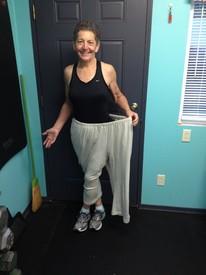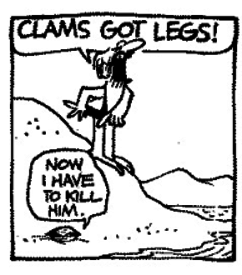I want to run. I'm scared to death of getting hurt

MsRuffBuffNStuff
Posts: 363 Member
Last time I made an attempt at running, I was 250 pounds. I had a "trainer". I wound up with plantar fasciitis and had to have foot surgery.
Now I'm at a normal weight and I'd like to run. I know I probably have terrible form. I don't know what I'm doing and I probably look like a floppy fish when I try...
I'm scared to death of getting hurt.
Are there any online programs / videos/ coaching programs for running?
Now I'm at a normal weight and I'd like to run. I know I probably have terrible form. I don't know what I'm doing and I probably look like a floppy fish when I try...
I'm scared to death of getting hurt.
Are there any online programs / videos/ coaching programs for running?
0
Replies
-
C25K3
-
cwolfman13 wrote: »C25K
This.
And keep reminding yourself that being a slow runner is okay. The #1 problem I see/hear/read is people trying to run too fast.4 -
Be patient, I could only manage 2mins the first time i tried to run in May but can now run for 40mins .
Am trying to get ready for a 10k run next year
I used the Couch 2 5k programme (as mentioned above) to develop slowly. So far no injuries. I have issues with my joints being a bit hypermobile and always thought running wouldnt be safe for me.
Take it slowly, good luck.
PS plus i have an app on my phone Runkeeper its free and tracks my time, my route and distance etc. It can be very motivating.1 -
C25K is a great training tool to get you used to running. Going slow is great for concentrating on form.
I can't find good articles on form because Runner's World seems to be making all their content premium.
My tips on form and general things that helped me:
1. Keep your feet under you, don't let your strides get ahead of you.
2. Hold yourself upright and keep your shoulders back and DOWN. Don't hunch them.
3. Try to strike with either the middle or ball of your foot rather than your heel
4. Keep your pelvis forward
5. Don't lock your knees at any point in your stride
6. Lean into your running from your ankles, don't lean into it with your neck out. Concentrate on keeping your chin a little tucked in so you don't strain your neck.
7. Go slow at first. Yes, even slower than you think slow is. Speed comes with time. You have a lot of muscles that have to learn and adapt to new movement patterns.
8. Strength train your hamstrings and glutes. Running is quad dominant.
9. STRETCH. Before and after. Walking lunges are great.6 -
definitely try c25k and go slower than you can imagine running could be.
don't be afraid to repeat weeks.
run on grass or soft surfaces and get fitted for shoes from a proper running store.
keep your steps short and cadence high) and try and keep your feet under you - ie. don't stride out in front - a good tip I saw on here earlier is that if you can see your foot when you are running then you are overstriding.
Ever seen Paula Radcliffe's face when she runs? No one calls her a floppy fish and yet.....0 -
definitely go slow and don't go too far too soon.....I wish I took this advice when I started as I got terrible knee pain. Slower the better to start with.....C25K is awsome0
-
C25K was too advanced for me when I first started. If you want to have a very slow start this is a good program to follow to condition your body and tendons to the running movement. You will be tempted to skip weeks, but since you have history of injury I suggest not to skip any weeks.
Once you are confident you could transition to something that involves more running like this (the green one). Don't be afraid of repeating weeks if you need to.
Personally, when I got half through that 20 minute program I switched to this one. Again, don't be afraid of repeating weeks or tweaking distances (I ran kilometers instead of miles for the long runs).
The run itself, take it very easy. Start at a speed that is so slow, if you go any slower your body forces itself to walk. This gradual slow progression and easy pace might help with injury prevention. For even better prevention, train your core and glutes and stretch after exercising, maybe even a foam roller if you're a bit tight or sore. You could also cycle your shoes so your foot doesn't hit the ground the exact same way every time stressing the exact same muscles and tendons.
How do I know? I started running obese and with a pre existing chronic injury so I needed to take it as slow as possible and be as careful as possible and it worked! I can run a whole hour now at my weight (I'm still obese). I run very slowly but I run!1 -
Maybe a bit obvious...but you can start with walking. Not strolling, but what I call power walking; at a good clip, around 4mph, you can do intervals faster & slower, just to get your legs, feet, knees used to it. I do a lot of Nordic walking in addition to power walking & jogging intervals. Good luck!3
-
Take it slow. Try walking for a couple of weeks and then move to mixing some running in with your walks. I used a couch to 5k app to get me started and my runs now are usually somewhere between 5-10 miles.0
-
Like @minniestar55 I walked a lot. Run slow and start say 30 seconds of running, 3 minutes of walking for 20 minutes and go from there. You're own pace is the right one.
Good luck!0 -
I started out basic walking at my heaviest. It was walking, to speed walking to run-walking (if you call what I did then running) to real running.
I quickly realized as I progressed and even made a few "over confident mistakes", that my bones, ligaments, tendons and other tissue like muscle, all needed to be able to handle all the load I put on them. It takes time to not only get your cardiovascular system "fit" but the rest of your body as well.
Find you a very beginner plan to follow.. I did not follow one myself and I probably should have. All the ones provided here are good starters.
So what makes you different is that you have a previous injury that may take away some focus or keep you in constant thought about that injury while you run, so slowest, slower to slow until you build the proper fitness and running fundamentals.
Take the time, do not be scared, and more over have fun. This should be an enjoyable exercise for you or anyone, just make sure your rest and recover between runs and you will be fine!
3 -
Last time I made an attempt at running, I was 250 pounds. I had a "trainer". I wound up with plantar fasciitis and had to have foot surgery.
Now I'm at a normal weight and I'd like to run. I know I probably have terrible form. I don't know what I'm doing and I probably look like a floppy fish when I try...
I'm scared to death of getting hurt.
Are there any online programs / videos/ coaching programs for running?
There is a very very VERY high chance you do have terrible form. But it's not your fault. It's our modern shoes and activities (like sitting at a desk for 8 hours a day) that have caused it. So don't be ashamed.
Don't want to get hurt? Find a REAL running coach and have help you fix your form (warning - it's tedious and boring, which is why no one does it and everyone gets hurt) and learn how to build up properly to the type of running you want to do.3 -
My suggestions would be
A good resource is the book Anatomy for Runners: Unlocking Your Athletic Potential for Health, Speed, and Injury Prevention"
Focus as much time on strength, stretch, drills as you do on running. Do real heavy strength work and PT exercises to prevent common injuries.
Look at the maf system https://philmaffetone.com/180-formula/ to help you build aerobic endurance with a reduced injury potential.
Foam Roll and do Yoga
Don't rush things!!!0 -
Get to a running store and get fitted for running shoes. I started running at 258 lbs, and I remember the embarrassment I felt at going in there, but they watched me run and helped me get the right shoes for me. I started slowly, short distances, and I remember the first time I could run a mile, it was amazing. Then as you run a bit more, the first mile is a liar, it comes with creaks and unexplained ouchies and your head telling you that you can't do it. But you can and you will. Last weekend I ran my first half marathon.5
-
Thanks so much to everyone for your advice! You've given me a lot of resources to get started :-)0
-
GottaBurnEmAll wrote: »C25K is a great training tool to get you used to running. Going slow is great for concentrating on form.
I can't find good articles on form because Runner's World seems to be making all their content premium.
My tips on form and general things that helped me:
1. Keep your feet under you, don't let your strides get ahead of you.
2. Hold yourself upright and keep your shoulders back and DOWN. Don't hunch them.
3. Try to strike with either the middle or ball of your foot rather than your heel
4. Keep your pelvis forward
5. Don't lock your knees at any point in your stride
6. Lean into your running from your ankles, don't lean into it with your neck out. Concentrate on keeping your chin a little tucked in so you don't strain your neck.
7. Go slow at first. Yes, even slower than you think slow is. Speed comes with time. You have a lot of muscles that have to learn and adapt to new movement patterns.
8. Strength train your hamstrings and glutes. Running is quad dominant.
9. STRETCH. Before and after. Walking lunges are great.
This is very good advice about form!! It's very important to make sure your foot lands directly underneath you and not out in front of your body or you will get injuries. Also, you don't want to land on your heels.
Here is an article about Form from Runner's World: http://www.runnersworld.com/run-faster/proper-running-form However, their are tons of articles and videos out there if you google them.
You might have someone video you running, or stick your phone in a bush and run by so you can make sure you are running in good form. Also, in addition to running, it helps to do strength exercises to develop your core, glutes and legs. Warming up and stretching afterwards are great. I also do yoga for runners and foam rolling a few times a week.
Make sure start gradually...don't add too many miles too quickly. It's so much better to make sure you are running in proper form so you don't learn by getting another injury.
Have fun and welcome back!0 -
I also say the c25k app it took me from 288lbs to where I am now and had me finish my first race last weekend.
Also the suggestion of runkeeper is a good one. I moved the couch to 5k workouts and programmed them into runkeeper because I'm a nerd who likes the numbers.1 -
I know I probably have terrible form. I don't know what I'm doing and I probably look like a floppy fish when I try...
Here's what i would do. First i would get approval to run from my doctor. Then i'd have a sports physical therapist assess my running form, preferably outside, not just on a treadmill. Then i'd follow any corrective stretches & exercises that the PT gives. Then i'd follow the other advice in this thread.
1 -
Before I even knew ab about the C25K app I conditioned myself to run by just starting out with a walk/run exercise of my own. I would walk at a brisk pace for a certain amount of mins/distance and then run and alternate between the two. The day finally came when I was no longer walking. Listen to your body and challenge yourself. You can do it!0
-
I tried couch to 5k about five times before I was able to finish it. What finally made a difference was
*having a good walking base - I walked regularly for about five months before I started
*being consistent - really run three days a week, not two days this week maybe four next week
*interesting audiobooks to keep me entertained when I'm running the same old trail
eta:
*finding a somewhat secluded place to run so I wouldn't be embarrassed (please be smart about that - keep your wits about you, be alert, tell people where you are, have your phone handy)
*using the c25k app instead of a piece of paper and a stopwatch
I'm not speedy and I don't have a big interest in running longer and longer distances, but I can run now for thirty or forty minutes straight and I feel pretty good about that.1 -
I, too, wanted to try running and was scared to death of injury, because everyone I know who's a runner has injuries, some which will affect them for the rest of their lives. I also have had various musculoskeletal issues and my body doesn't always respond well to new exercise. ((61 yo) I was within 5-10 lbs of my normal weight range. It was much easier for me than when I was 50 lbs overweight, the last time I had tried running. I also now had an additional year of workouts/strength training so my overall fitness level was much better.
I started out with c25k last Feb, with the attitude that I would go as far as my body would let me. I trained usually 2x per week instead of 3, simply because I did not want to cut back on my other 3 workouts and I found I needed 2 rest days. I also promised myself and my husband that if I started to develop any issues, I would take a break or stop. I developed a thorough warm up routine of squats & lunges which I did religiously and also stretched thoroughly afterwards. I proceeded through c25k with no problems AT ALL. Although at then end I could run 30 minutes without stopping, it took awhile longer to get to a 5k distance with no stops. I accomplished this at the end of August!
Based on my conversations with others, many running injuries result from people pushing too hard too fast too soon, not giving themselves adequate rest/recovery time, and not doing good warmups and cooldowns.
Honestly, if "I" can accomplish this, I think that most people can, barring any significant medical issues. I had never ever run in my life and even in jr high I could not complete the 600 yd without walking (this was the longest run done in PE class back then).2 -
amusedmonkey wrote: »C25K was too advanced for me when I first started. If you want to have a very slow start this
not the op, but thanks for this. c25k buried me for a few weeks when i tried it out recently, and i was actually sad because for once i really wanted to do it and could see it happening. plantar fascitis isn't my thing, but i think i'm in about the same boat as the o.p. for other reasons.0 -
The main rule to stay injury free while running is to first establish a base distance/time that you can run without pain. That's ZERO pain. None. Then increase that a maximum of 10% a week. So if you can run 1 mile at a time, three times a week, then the next week only run 1.1 miles at a time those same three times. If you decide to add a fourth day then decrease the amount you run each day to honor that 10% rule.
Obviously it's a little tricky if you're running outside, but you can always walk when you get beyond the distance you want to run.0 -
Not read though all comments but having proper gait assessment done to choose the right trainers and or insoles for you is very important0
-
canadianlbs wrote: »amusedmonkey wrote: »C25K was too advanced for me when I first started. If you want to have a very slow start this
not the op, but thanks for this. c25k buried me for a few weeks when i tried it out recently, and i was actually sad because for once i really wanted to do it and could see it happening. plantar fascitis isn't my thing, but i think i'm in about the same boat as the o.p. for other reasons.
You are welcome. The program is very gentle but very effective for conditioning. If I kept trying to do C25K I would have quit long ago. The progression jumps can be steep and I felt like I was pushing myself too hard. The first week gave me shin splints, and I my ankles just couldn't handle a 3 minute run on the 3rd week. I'm glad I found it. After the initial 8 weeks I was able to tackle a 30 second and even a 60 second run without my legs falling apart like they did on first week of C25K.1
This discussion has been closed.
Categories
- All Categories
- 1.4M Health, Wellness and Goals
- 398.1K Introduce Yourself
- 44.7K Getting Started
- 261K Health and Weight Loss
- 176.4K Food and Nutrition
- 47.7K Recipes
- 233K Fitness and Exercise
- 462 Sleep, Mindfulness and Overall Wellness
- 6.5K Goal: Maintaining Weight
- 8.7K Goal: Gaining Weight and Body Building
- 153.5K Motivation and Support
- 8.4K Challenges
- 1.4K Debate Club
- 96.5K Chit-Chat
- 2.6K Fun and Games
- 4.8K MyFitnessPal Information
- 12 News and Announcements
- 21 MyFitnessPal Academy
- 1.5K Feature Suggestions and Ideas
- 3.2K MyFitnessPal Tech Support Questions






















